Tokyo, Japan - July 12, 2017 - A Japanese partnership, consisting of the Kanagawa Prefectural Government, the municipal governments of the cities of Yokohama and Kawasaki, Iwatani Corporation, Toshiba Corporation, Toyota Motor Corporation, Toyota Industries Corporation, Toyota Turbine and Systems, Inc., and Japan Environment Systems Co., Ltd. announced today that all facilities to be used in the FY2015 Regional Cooperation and Low-carbon Hydrogen Technology Demonstration Project commissioned by the Ministry of the Environment have been completed, and full-scale operations have commenced.
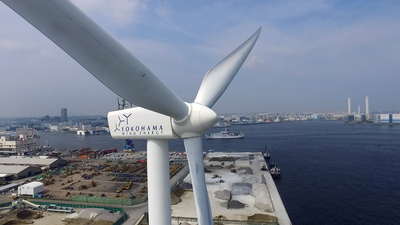 |
Yokohama City Wind Power Plant (Hama Wing).
Photo courtesy of Toyota |
| |
Tokyo, Japan - July 12, 2017
Kanagawa Prefectural Government
City of Yokohama
Kawasaki City
Iwatani Corporation
Toshiba Corporation
Toyota Motor Corporation
Toyota Industries Corporation
Toyota Turbine and Systems, Inc.
Japan Environment Systems Co., Ltd.
A Japanese partnership, consisting of the Kanagawa Prefectural Government, the municipal governments of the cities of Yokohama and Kawasaki, Iwatani Corporation, Toshiba Corporation, Toyota Motor Corporation, Toyota Industries Corporation, Toyota Turbine and Systems, Inc., and Japan Environment Systems Co., Ltd. announced today that all facilities to be used in the FY2015 Regional Cooperation and Low-carbon Hydrogen Technology Demonstration Project commissioned by the Ministry of the Environment have been completed, and full-scale operations have commenced.
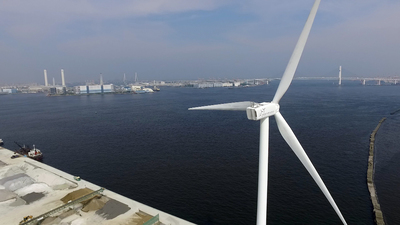 |
Yokohama City Wind Power Plant (Hama Wing).
Photo courtesy of Toyota |
| |
The goal of the project is to implement and evaluate a low-carbon hydrogen supply chain which will utilize hydrogen produced from renewable energy in facilities along Tokyo Bay (in Yokohama and Kawasaki) to power forklifts.
A system has been created for using electricity generated at the Yokohama City Wind Power Plant (Hama Wing) to electrolyze water to create low-carbon hydrogen, which is then compressed and stored.
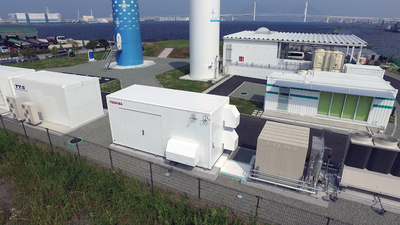 |
Hydrogen Supply Point
Photo courtesy of Toyota |
| |
The hydrogen produced at the site will be transported in a hydrogen fueling truck to a fruit and vegetable market, a factory, and warehouses.
The hydrogen will be used in fuel cells to power forklifts at these locations.
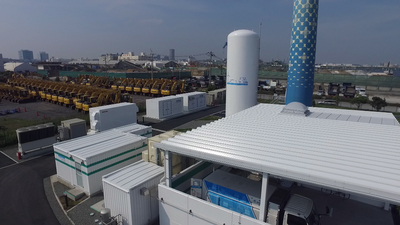 |
Hydrogen Supply Point
Photo courtesy of Toyota |
| |
The creation of this hydrogen supply chain in cooperation with local partners is expected to reduce CO2 emissions by at least 80 percent when compared with a supply chain using forklifts powered by gasoline or grid electricity.
The goal of the project is to establish a hydrogen supply chain, analyze costs, and estimate potential CO2 reductions that can be achieved with a full-scale supply chain in the future.
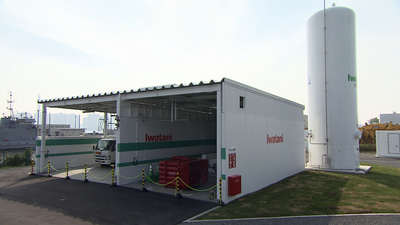 |
Hydrogen storage and compression system.
Photo courtesy of Toyota |
| |
Wow, you're making hydrogen from wind and water?
Do you know what the most abundant element in the universe is?
It's hydrogen (H).
The intense energy of the sun, like that of all the stars that shine in the night sky, comes almost entirely from hydrogen.
So, where would you find hydrogen on Earth?
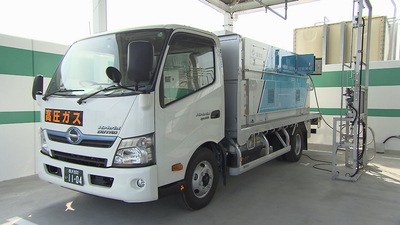 |
Hydrogen fueling truck
Photo courtesy of Toyota |
| |
Well, hydrogen is a colorless, odorless gas, practically non-existent in its molecular form.
However, as a compound, it exists in virtually endless supply.
Among hydrogen compounds found above ground, by far the most common is… water (H2O).
Isn't it fascinating to consider that the hydrogen that exists in such vast quantities in outer space takes on the form of water here on Earth?
Have you heard about a unique project that's happening right now in Yokohama?
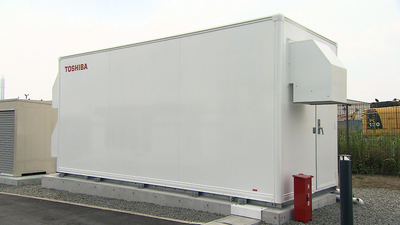 |
Water electrolysis system
Photo courtesy of Toyota |
| |
There, in the outskirts of the Minato Mirai district, the harbor gusts affectionately referred to as the "Hama Winds" are being used to generate hydrogen, which is stored and then transported to be utilized as fuel for forklifts.
Shall we take a closer look at how this project works?
Here we are at the Mizuho pier in northern Minato Mirai.
After passing through the warehouse district right down to end of the pier, we see an area as extensive as a schoolyard.
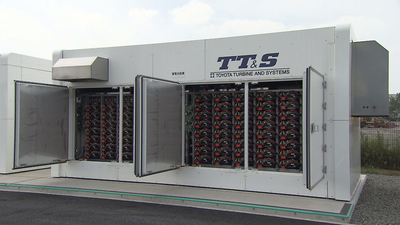 |
Hydrogen production stabilization system
Photo courtesy of Toyota |
| |
The first thing to catch our eye is a broad pillar.
As our gaze travels up its heights, we see a large, white windmill churning the air.
It turns out this windmill belongs to a wind power plant called the Hama Wing.
The tower is 78 m high and the windmill's massive blades extend across an 80-meter span!
Apparently, this allows it to generate roughly 2.2GW of electricity a year, enough to annually power about 500 homes - and all that electricity is now being put to work generating hydrogen!
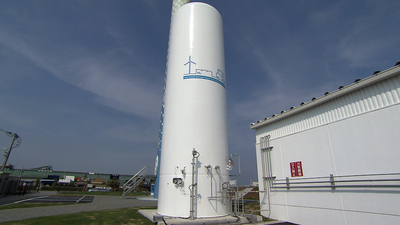 |
Hydrogen storage tank
Photo courtesy of Toyota |
| |
Let's head to the site.
Up close, we hear the hum of the windmill driven by the Hama Winds.
Upon approaching the pillar, it almost seems as though we're looking into the boarding bay of a rocket, but it's actually just the entrance to Hama Wing.
So why don't we climb the stairs and peek inside?
Looking up from within, we see that the tower is hollow right to the top and a ladder clings to the inner wall, rising all the way up.
It would seem that maintenance workers are required to climb up to the top decked out in safety gear.
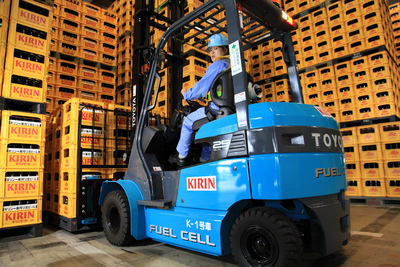 |
Hydrogen Utilization
Photo courtesy of Toyota |
| |
Incredible!
You need great strength and courage to perform such an arduous task.
It makes you wonder if they ever wish for an elevator.
Stepping back outside, we're now in front of facilities resembling huge, white storage sheds.
One of them awaits with doors parted like open arms.
This calls for a closer look. Inside are black rectangular objects stacked in order… Apparently, they're batteries.
In fact, the purpose of these facilities is to store surplus electricity from the Hama Wing in this storage battery system…which is comprised of recycled Prius batteries.
There are 180 Prius' worth lined up in there.
Now for another kind of storage found next to the Storage Battery System.
It's marked with a "TOSHIBA" logo.
What on earth could it be?
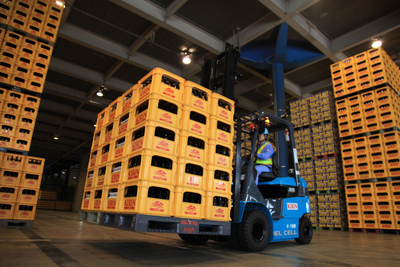 |
Hydrogen Utilization
Photo courtesy of Toyota |
| |
This is the Water Electrolysis System, which produces hydrogen from water.
Closer up, we see that tap water is supplied to it near the door on the right.
The water is split into its constituent elements using the electricity generated by the Hama Wing and hydrogen is extracted.
With a tingling of anticipation, we open the door to find a white, box-shaped object taking up residence within the storage unit.
This is the Electrolyzer that extracts hydrogen from the water.
Let's delve a little deeper.
There's just enough room for one person to squeeze through at a time but once we make our way through the passage, we come out behind the Electrolyzer.
We can't see into the unit but asking buys us the answer to the question, "From where does the hydrogen come out of?"
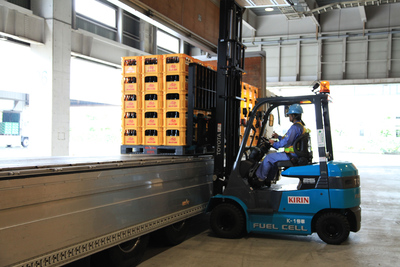 |
Hydrogen Utilization
Photo courtesy of Toyota |
| |
The answer is that it passes through the silver-colored pipes emerging upward from the Electrolyzer.
Light as it is, hydrogen floats up from below.
Those are some surprisingly thin pipes.
The next step should be storage of the hydrogen, right?
As we look out across the grounds, wondering which facility serves that purpose, we notice a large cylinder near the center of the compound. It must be as tall as 10 meters.
Craning our necks back we see the logo of the project emblazoned across the stark white of the cylinder's face.
The hydrogen that has been generated is bound for fuel cell (FC)-powered forklifts and, apparently, enough hydrogen is stored in there to power 12 forklifts for two days!
Energy can be stored much longer as H2 than as electricity (electricity discharges energy over time) - a longer storage period is one of the merits of hydrogen.
Though we might think that transporting the hydrogen comes next, it turns out another process comes first - compression.
We are led to an area with a ceiling surrounded by three walls adjacent to the hydrogen storage tank, where the hydrogen compressor can be found.
One might imagine the "compressor" it to be a very large piece of equipment, but it's a surprisingly compact machine at about 2 m in height.
Apparently, this is a biaxial vertical hydrogen compressor - a compact design.
Moving on to the booth beside the compressor, we find a small truck waiting.
It's adorned with the same project logo as the hydrogen storage tank.
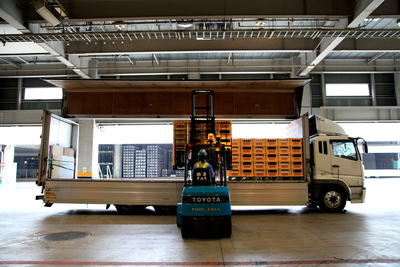 |
Hydrogen Utilization
Photo courtesy of Toyota |
| |
This is the first hydrogen fueling truck introduced for FC forklifts in Japan.
The hydrogen compressed in the device we just visited will be transported to sites where FC forklifts will utilize the hydrogen from the hydrogen fueling truck.
Enough fuel for six forklifts can be transported at once…
It's tempting to wonder if it would be more efficient to deliver more using an even bigger truck but we learn that there are a lot of narrow areas at the site where the forklifts are used, which explains the smaller trucks.
Let's recap what we've learned about this project: the wind-generated electricity of the Hama Wing is used to extract low-carbon hydrogen from water; the H2 is stored, conveyed, and utilized, - all helping realize a low-carbon hydrogen supply chain model.
Seeing the process of Earth-bound hydrogen contained in water being extracted and then transported gives us a peek at a future in which hydrogen will surely be a far more common form of energy.
1. Project Overview
The project includes
• a system to produce hydrogen by electrolyzing water using wind power
• a system to optimize storage and transportation of hydrogen
• use of fuel cell forklifts
• a hydrogen supply chain feasibility study
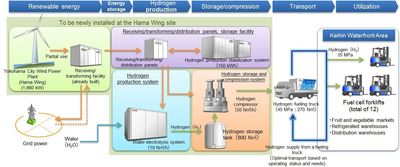 |
Project System Flow
Courtesy of Toyota |
| |
2. Specific items to be verified by the project
The business case for hydrogen supply chains and future expansion to other regions will be verified, through cost analysis and measurement of the project's contribution to global warming countermeasures.
Hydrogen cost
• The demonstration project will use evaluations of current conditions (demonstration project costs) to examine future courses of action required to reduce hydrogen costs, including verification of savings from economies of scale and identification of the steps needed to implement deregulation.
• The project will also examine the development of a promotional and deployment model through technological innovation, as well as the development of full-scale supply chains, based on projections of needs in 2030.
CO2 emissions reductions
• The project aims to construct a low-carbon hydrogen supply chain that can reduce overall CO2 emissions by at least 80% when compared with conventional approaches.
• The project will examine measures for further reducing CO2 emissions.
3. Overview of future full-scale operations (from July 2017)
• Commencement of low-carbon hydrogen production using power from Hama Wing
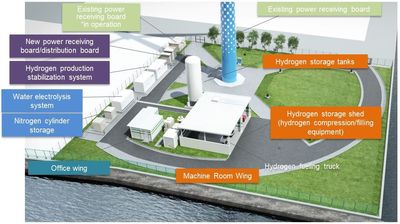 |
Model of Hama Wing site premises (Japan Environment Systems) Co., Ltd.
Courtesy of Toyota |
| |
• Verification of hydrogen supply using 12 fuel cell forklifts and two hydrogen fueling trucks
• Cloud-based management and operation, from hydrogen production to usage
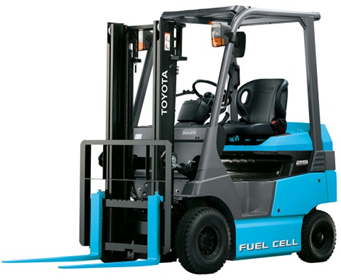 |
Fuel Cell Forklift (Toyota Industries Corporation).
Photo courtesy of Toyota |
| |
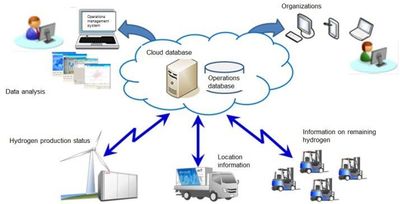 |
Diagram of management system
Courtesy of Toyota |
| |
4. Schedule
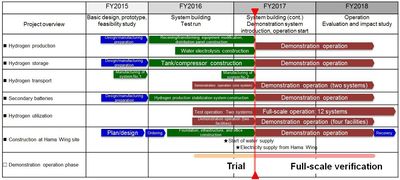 |
Note: Factors such as future discussions with the Ministry of the Environment may cause changes to the demonstration details and implementation plan.
Courtesy of Toyota |
| |
5. Results of full-scale operation pilot trial (November 2016 to July 2017)
Trial objectives
• To acquire proficiency in hydrogen supplying and filling work
• To gain further knowledge of hydrogen and fuel cells
• To complete the pilot deployment of fuel cell forklifts
Overview
• One forklift was deployed to the Yokohama City Central Wholesale Market and one to Nakamura Logistics for test runs.
• A hydrogen fueling truck from the Iwatani Industrial Gases Corp. Chiba plant was used to deliver hydrogen.
Evaluation of trial
• Compared to forklifts powered by electricity, fuel cell forklifts had shorter recharging times, were used flexibly without issues, and were generally well reviewed.
• There were requests for more frequent hydrogen deliveries in order to improve fuel cell forklift uptime.
Reference
1. Hydrogen production system through water electrolysis using wind power
Hydrogen Production
• Hydrogen will be produced through a water electrolysis system powered by renewable energy generated at Hama Wing.
• The management system will enable flexible, low-carbon hydrogen production that accounts for temporary discrepancies between power output and hydrogen demand.
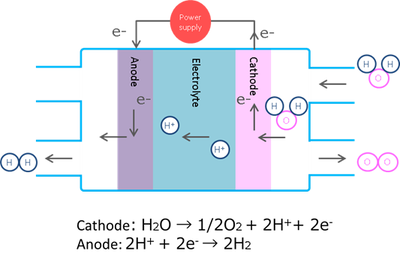 |
Water electrolysis
Courtesy of Toyota |
| |
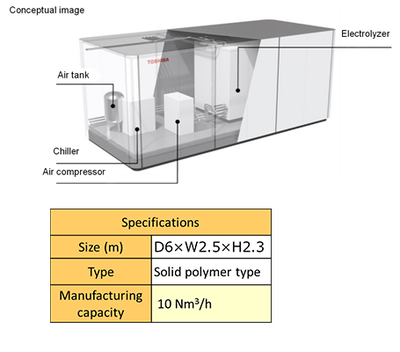 |
Water Electrolysis System (Toshiba Corporation)
Courtesy of Toyota |
| |
2. System to optimize storage and transportation of hydrogen
Hydrogen Storage and Compression
• Sufficient hydrogen to power fuel cells for two days will be stored on-site.
• Electricity will also be stored in an environmentally friendly storage battery system that re-uses batteries from hybrid vehicle batteries, thus ensuring a stable hydrogen supply even when Hama Wing is not operational.
 |
Storage Battery System (Toyota Turbine and Systems Inc.)
Photo courtesy of Toyota |
| |
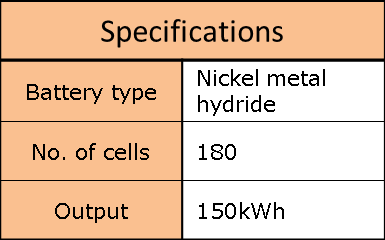 |
Storage Battery System (Toyota Turbine and Systems Inc.)
Courtesy of Toyota |
| |
Hydrogen Transportation
• The hydrogen will be compressed for use in forklifts and delivered in hydrogen fueling trucks (the first of their kind to be used in Japan).
• The consumption of hydrogen by the forklifts will be continuously monitored, so as to ensure optimal transportation and supply to meet user needs.
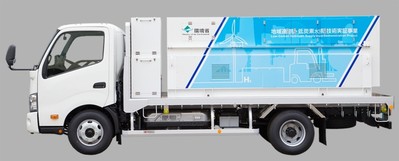 |
Hydrogen Fueling Trucks (Iwatani Corporation)
Photo courtesy of Toyota |
| |
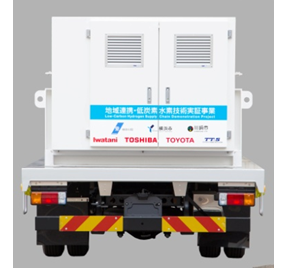 |
Hydrogen Fueling Trucks (Iwatani Corporation)
Photo courtesy of Toyota |
| |
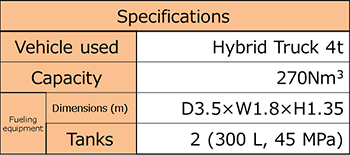 |
Hydrogen Fueling Trucks (Iwatani Corporation)
Photo courtesy of Toyota |
| |
3. Use of fuel cell forklifts
Hydrogen Utilization
• Twelve forklifts will operate at the four selected locations to demonstrate their viability in a range of operating conditions.
• Fuel cell-powered forklifts, which Toyota launched in November 2016, emit zero CO2 during operation.
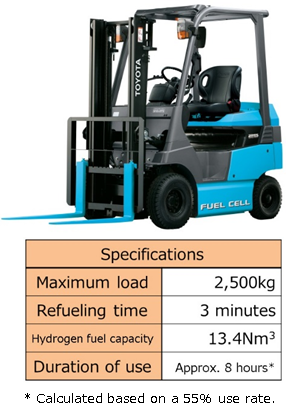 |
Fuel Cell Forklift (Toyota Industries Corporation)
Photo courtesy of Toyota |
| |
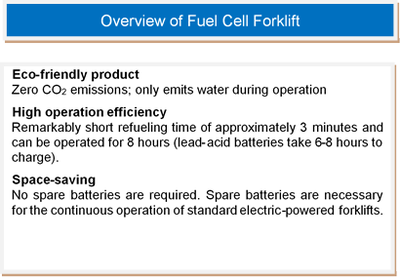 |
Fuel Cell Forklift (Toyota Industries Corporation)
Photo courtesy of Toyota |
| |
 |
Names and locations of facilities using fuel cell forklifts, and dates of introduction.
Courtesy of Toyota |
| |
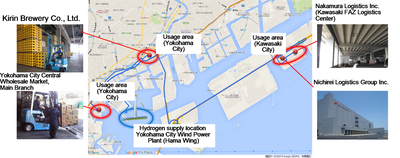 |
Map of locations where fuel cell forklifts will be used and hydrogen transportation routes.
Courtesy of Toyota |
| |
Source: Toyota Global Newsroom
http://newsroom.toyota.co.jp/en/
ASTROMAN Magazine - 2017.07.07
Toyota Opens Billion-Dollar, State-of-the-Art North American Headquarters in Texas
https://www.astroman.com.pl/index.php?mod=magazine&a=read&id=2291
ASTROMAN Magazine - 2017.04.22
Toyota Opens a Portal to the Future of Zero Emission Trucking for Heavy Duty Truck Use at the Port of Los Angeles
https://www.astroman.com.pl/index.php?mod=magazine&a=read&id=2234
ASTROMAN Magazine - 2017.03.11
Toyota i-TRIL concept at Geneva International Motor Show 2017
https://www.astroman.com.pl/index.php?mod=magazine&a=read&id=2208
ASTROMAN Magazine - 2016.12.17
Toyota Launches the New C-HR
https://www.astroman.com.pl/index.php?mod=magazine&a=read&id=2172
ASTROMAN Magazine - 2016.12.03
Toyota Motor Corp. Announces the Launch of its New Free Smartphone Navigation App, the TC Smartphone Navigation
https://www.astroman.com.pl/index.php?mod=magazine&a=read&id=2166
ASTROMAN Magazine - 2016.11.04
Toyota Launches a New Boat, the New Ponam-28V Premium Sports Cruiser
https://www.astroman.com.pl/index.php?mod=magazine&a=read&id=2151
ASTROMAN Magazine - 2016.07.02
Toyota Motor Corporation Announces Regular Personnel Changes
https://www.astroman.com.pl/index.php?mod=magazine&a=read&id=2083
ASTROMAN Magazine - 2016.06.25
Toyota launches Biodiversity & Sustainability Learning Center to complement its Biotope project in Thailand
https://www.astroman.com.pl/index.php?mod=magazine&a=read&id=2081
ASTROMAN Magazine - 2016.04.09
Toyota Announces New Venture with Microsoft 'Toyota Connected', Expands Focus on Software- and Data-Driven Mobility
https://www.astroman.com.pl/index.php?mod=magazine&a=read&id=2052
ASTROMAN Magazine - 2016.03.14
The 86th Geneva International Motor Show: An exceptional vintage!
https://www.astroman.com.pl/index.php?mod=magazine&a=read&id=2040
ASTROMAN Magazine - 2016.01.17
North American International Auto Show Announces Technology Partnership with IBM
https://www.astroman.com.pl/index.php?mod=magazine&a=read&id=2012
ASTROMAN Magazine - 2016.01.15
2016 North American International Auto Show Drives It Home With 50-Plus Production and Concept Reveals
https://www.astroman.com.pl/index.php?mod=magazine&a=read&id=2011
ASTROMAN Magazine - 2016.01.08
CES 2016 Opens with Technology Changing the World
https://www.astroman.com.pl/index.php?mod=magazine&a=read&id=2007
ASTROMAN Magazine - 2015.11.07
The 44th Tokyo Motor Show 2015 - The city of the future feel and experience the connection between cars, lifestyles and society
https://www.astroman.com.pl/index.php?mod=magazine&a=read&id=1990
ASTROMAN Magazine - 2015.11.01
The 44th Tokyo Motor Show 2015
https://www.astroman.com.pl/index.php?mod=magazine&a=read&id=1988
Editor-in-Chief of ASTROMAN magazine: Roman Wojtala, Ph.D.
|

